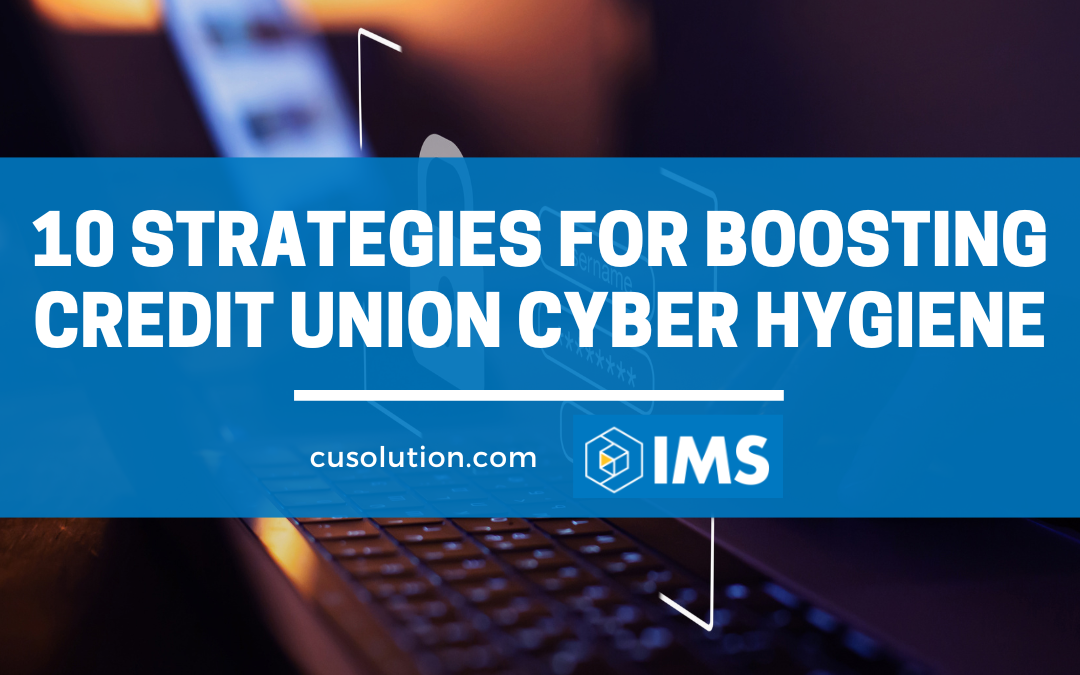As we recognize Cybersecurity Awareness Month, there’s no better time to reflect on why cybersecurity matters to the credit union community. Today’s interconnected world means there are near-infinite possibilities for credit union growth and member engagement. However, it also presents vast challenges, especially regarding credit union cyber hygiene. Threats from cybercriminals targeting financial institutions are constantly escalating, posing significant risks to sensitive member data and financial operations.
This blog aims to empower credit union leaders and IT professionals with effective strategies to bolster their institution’s cybersecurity efforts. By taking a proactive approach, you can considerably reduce the likelihood of a breach and protect your credit union.
Credit Union Cyber Hygiene: Safeguarding Member Data
The stakes are undeniably high. Did you know that the annual financial risks due to cyber threats can range from $190,000 for small credit unions to $1.2 million for large credit unions?
Business email compromise schemes are by far the costliest financial cybercrime. According to research, victims of email compromise reported approximately $2.4 billion in losses in 2021 alone. These numbers underscore the importance of robust cyber hygiene practices for credit unions. Beyond the financial impact, consider the cost to your institution’s reputation, the potential loss of members, and the operational disruptions.
These trends cannot be ignored, and while daunting, they serve as catalysts for every credit union to prioritize its cybersecurity posture and scale up its defenses. Let’s take a look at 10 strategies for boosting your credit union cyber hygiene:
1. Perform Regular Audits and Assessments
Implementing rigorous audits and assessments will help identify vulnerabilities in your credit union’s security infrastructure. Routine assessments ensure proper security measures are in place and protocols remain updated when changes are made to the IT environment. Also, continuously examining server and workstation logs can effectively identify suspicious activities.
2. Educate Employees on Cyber Hygiene
Employees often constitute the first line of defense against cyber threats. Training is crucial to equip them with knowledge and practical skills to recognize and prevent phishing attacks, ransomware, and malicious downloads. Encourage safe practices, such as strong password management, to mitigate risks arising from human error.
3. Develop a Comprehensive Security Policy
Develop a comprehensive security policy addressing the credit union’s IT infrastructure, user authentication protocols, and data classification. This policy should outline procedures for reporting security incidents, handling sensitive information, and monitoring third-party service providers to ensure they adhere to data protection standards.
4. Deploy Multi-layered Security Measures
Implementing a multi-layered security approach enhances your credit union’s ability to withstand various threats and attacks. Deploying a combination of firewalls, intrusion detection and prevention systems (IDPS), email filtering, and spam protection reinforces security measures and ensures the swift detection of cyber threats.
5. Keep Hardware and Software Up-to-date
Software and firmware updates are essential to patch vulnerabilities and exploit loopholes that hackers use to infiltrate networks. Implement a systematic approach to managing updates, establishing clear patch timelines, and prioritizing the most critical vulnerabilities.
6. Optimize IT Utilization
Cyber resilience in credit unions can be substantially improved through the diligent use of technologies. While certain programs or infrastructure such as Microsoft 365 can bring significant benefits to credit unions, there is always a need for a proper understanding of security recommendations and best practices.
7. Secure The Cloud
The transition to cloud computing offers significant benefits, such as cost-saving on data storage and streamlined operations. However, the security of digital assets in the cloud remains a top concern. Credit unions should securely configure cloud services, encrypt sensitive data, and restrict access to authorized personnel to mitigate cloud-related risks.
8. Monitor Vendor Security and Risk Management
Credit unions often rely on third-party vendors to provide essential services and support operations. It’s crucial to diligently assess vendors’ security standards and risk management practices to ensure they align with your credit union’s expectations. Regular vendor audits and thorough risk assessments will strengthen your institution’s overall cyber hygiene.
9. Implement Robust Authentication Practices
Implement strong authentication mechanisms such as multi-factor authentication (MFA) to bolster access security for members and internal employees. MFA provides an additional layer of security beyond passwords and significantly reduces the risk of unauthorized access to sensitive information.
10. Plan for Disaster Recovery and Business Continuity
The ability to quickly recover from a cyber attack or security incident is crucial to maintaining a credit union’s operations and reputation. Develop a comprehensive disaster recovery and business continuity plan that includes frequent data backups, off-site storage of critical data, and protocols for resuming operations in case of a breach.
Elevating Credit Union Cyber Hygiene with Virtual Private Cloud Services
Protecting your credit union from cyber threats is an ongoing and evolving endeavor, necessitating a comprehensive and proactive approach. Implementing these strategies will help to significantly improve your credit union’s cyber hygiene, reducing the likelihood of a cyberattack and mitigating its impact if it does occur. By continuously monitoring and evaluating your institution’s security posture, you can stay ahead of threats and protect sensitive member data, ensuring trust and confidence in your credit union.
Partnering with a leading IT service provider like IMS can significantly streamline your credit union’s path to robust cybersecurity. Our Virtual Private Cloud Services — including backup, disaster recovery, Infrastructure-as-a-Service, compliance, and more — provide a comprehensive solution tailored specifically for credit unions. Connect with IMS to explore how we can help safeguard and empower your credit union with our industry-leading IT solutions.

